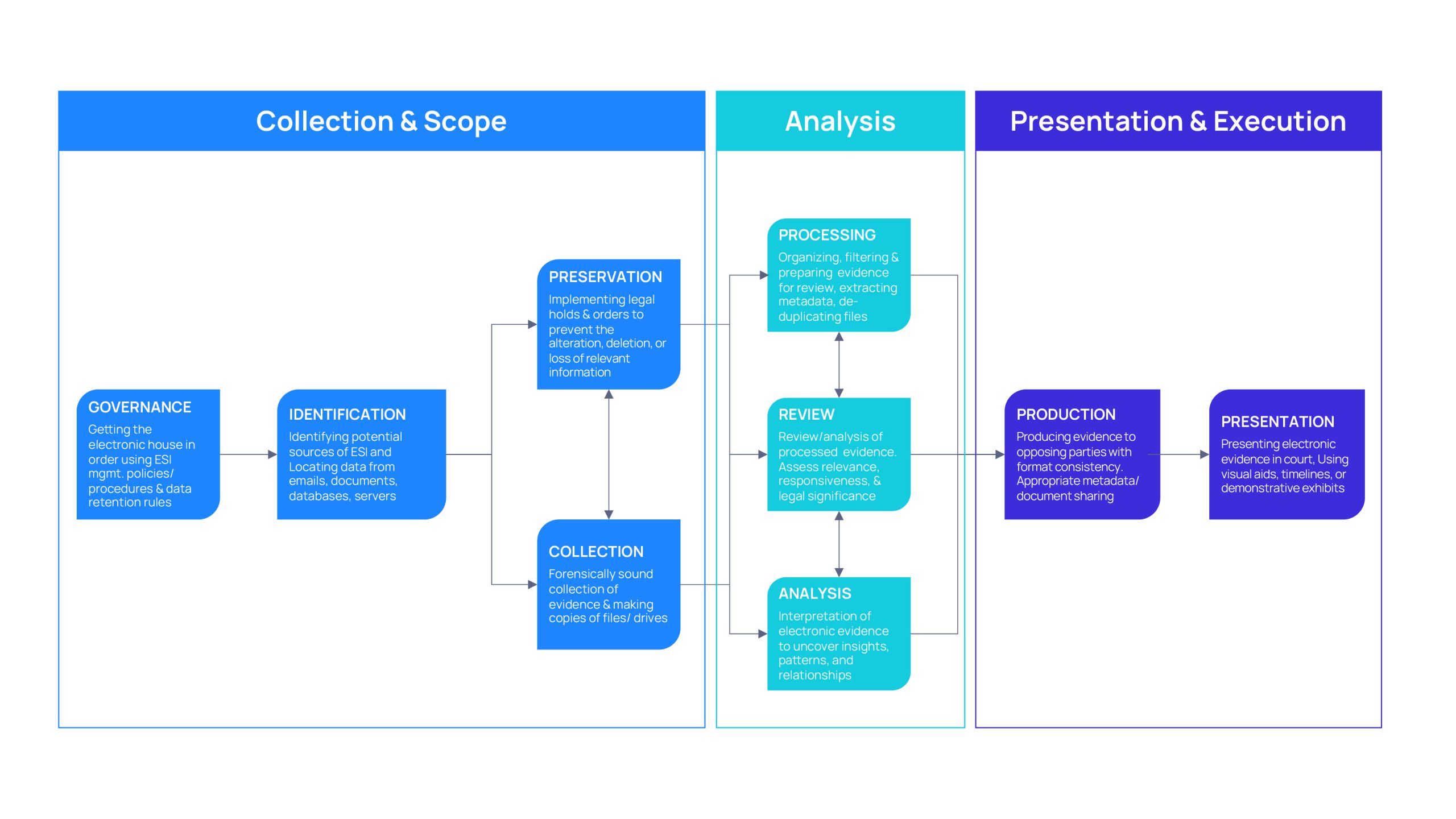Introduction to E-Discovery in Legal
In legal trials, evidence-based arguments heavily influence trial outcomes, prompting lawyers to invest substantial time and resources in gathering evidence before a trial. This evidence typically comes in various formats, such as interrogations, confessions, depositions, and documents, most of which are now being digitized. The process of collecting this evidence is referred to as ‘discovery’ in legal terms. E-discovery, which involves managing large volumes of electronic data, has become a vital component of modern litigation.
However, merely digitizing discovery is not enough. Conducting e-discovery today faces numerous challenges, the most pressing being the increasing variety of data types that need to be managed. According to the latest quarterly e-discovery Business Confidence Survey by Complex Discovery, “increasing types of data” was identified as the top issue impacting the e-discovery business over the next six months by nearly 37% of respondents. This concern significantly outweighed the next-highest issue, “budgetary constraints,” which was selected by 19.72% of respondents.
This trend is not a one-time occurrence. Analysis by eDiscoveryToday reveals that “increasing types of data” has been the leading concern in seven of the last eight fiscal quarters. Another survey indicated that 47% of respondents believe their organizations would struggle to keep up with the rapid growth in data volumes.
Navigating E-Discovery Challenges
Data volume and variety are just the tip of the iceberg. Other critical challenges include ensuring data privacy and security, managing high costs, navigating complex regulatory compliance, and filtering massive amounts of data to identify relevant information. These issues highlight the complexity and scale of modern e-discovery.
Traditional methods struggle to meet these demands, but generative AI (Gen AI) offers a transformative solution. Gen AI can streamline and enhance the e-discovery process, efficiently handling large volumes and varieties of data, ensuring sensitive information is protected, automating labor-intensive tasks to reduce costs, keeping up to date with regulatory changes, and improving the overall efficiency and effectiveness of the e-discovery value chain.
Gen AI-powered E-Discovery

With the large volumes of both structured and unstructured data that lawyers usually have to analyze manually, Gen AI can greatly improve the actions, outcomes, costs, and efficiency of each case. The American Bar Association notes that 62% of lawyers already use some type of traditional e-discovery solution, making this area more suitable for automation compared to other legal uses of Gen AI.
Collection and Scope
Save 25-30% time with greater precision and compliance, ensuring solid evidence and preventing information loss.
- Information Governance
Gen AI streamlines data classification and management, improving data integrity and accessibility. It supports regulatory compliance by identifying and flagging potential risks and violations, helping organizations adhere to relevant regulations. With Gen AI integration, information governance shifts from a reactive approach to a proactive one, decreasing the chances of breaches and non-compliance and allowing organizations to use their data and information as strategic assets.
Gen AI is vital for data redaction, helping comply with privacy regulations related to personally identifiable information (PII) and privileged information. By employing advanced data masking and redaction techniques, AI algorithms can automatically detect and redact sensitive information from documents, reducing the risk of accidental disclosure and ensuring adherence to data protection laws.
- Identification
Gen AI can rapidly sift through large data volumes to pinpoint crucial documents and relevant information. Using natural language processing (NLP) techniques, AI algorithms can examine text, metadata, and other attributes to find documents pertinent to specific legal issues. This boosts the efficiency of legal teams by cutting down the time and effort needed for manual document review. Additionally, it can evaluate the legitimacy and strength of claims by analyzing vast amounts of data.
- Collection
Generative AI can retrieve data from both unstructured and semi-structured documents, allowing legal teams to access and examine information more effectively. By interpreting text, extracting key entities, and identifying relationships, AI algorithms convert unstructured data into structured formats, simplifying the process of searching, filtering, and analyzing vast amounts of data.
The technology ensures format consistency by converting speech and video into text in real time. By transcribing audio and video recordings into text, AI makes the content searchable and analyzable, aiding in the extraction of pertinent information during the e-discovery process.
- Preservation
By continually analyzing data usage patterns, access logs, and metadata, AI algorithms can identify changes or anomalies that suggest tampering or unauthorized access, thereby proactively protecting critical data from loss or corruption. Moreover, utilizing natural language processing (NLP) and machine learning, AI can automatically analyze legal documents and case-related information to create comprehensive legal holds and preservation orders.
Analysis
Gain up to 45% in time and effort by extracting key information, identifying trends, and speeding up legal decisions
- Processing
Generative AI can automate the classification of documents and create summarized views to simplify the review process. By examining content, context, and metadata, AI algorithms can categorize documents according to relevance, privilege, and other case-specific criteria, minimizing the manual effort needed for organization and review. Additionally, Generative AI can convert data into searchable text formats, improving accessibility and allowing for more detailed analysis by transforming scanned documents, images, and other non-textual data into machine-readable formats.
- Review
Review workflows are often intricate, involving multiple steps, and the unique requirements of each case can make managing these workflows a full-time job, prone to errors. Generative AI can automate the creation of tailored workflows to facilitate the routing and distribution of documents. This automation streamlines the document review process, enhancing accuracy and defensibility while accommodating the specific needs of each case.
Generative AI models can also automatically review and classify document collections based on relevance, privilege, and other case-specific criteria. The technology not only classifies each document but can also provide a confidence level for the classification and often a brief explanation for the classification decision.
- Analysis
Generative AI can detect unusual patterns or anomalies in data that may signal important information or misconduct, aiding in investigations and compliance monitoring. For example, AI can identify variations in email exchanges around significant events, uncommon references or terminology that might suggest deception, changes in the tone or sentiment of communications over time, and unusual transactions or transaction patterns.
Presentation and Execution
Reduce efforts by 30% in creating visuals, interactive exhibits, and shareable, compliant data for counsels
- Production
Generative AI can extract essential facts, dates, and figures from Electronically Stored Information (ESI) and produce summaries of evidentiary documents and depositions, complete with citations to the referenced excerpts. This capability streamlines the process of understanding document content without the need to delve into every detail.
It can generate compliant and shareable datasets containing relevant metadata, easing collaboration with opposing counsel. By analyzing content, context, and metadata, Gen AI algorithms can compile and structure documents that meet legal standards and promote efficient information exchange between parties. Additionally, Gen AI ensures consistency and accuracy in data presentation, reducing errors and discrepancies in the materials produced.
- Presentation
Generative AI creates compelling visualizations, exhibits, timelines, strategies, and scenarios to strengthen legal arguments. By analyzing content, context, and audience preferences, AI produces visually appealing presentations conveying key messages effectively. AI also integrates data from various sources, helping legal teams craft persuasive narratives for stakeholders and decision-makers.
While these are some possible use cases, lawyers have been leveraging Gen AI technology to streamline e-discovery workflows, mainly focusing on sentiment analysis and classification. For instance, in sentiment analysis, natural language processing identifies attitudes, sentiments, or emotions within documents. This capability enables legal teams to prioritize documents that are more likely to be relevant, identify patterns in communication pertinent to a case, and flag content with strong negative sentiment for further review.
Automated classification employs advanced algorithms and machine learning models to organize information into predefined classes or categories. This is particularly useful for identifying personally identifiable information (PII), protected health information (PHI), or other sensitive data and for detecting and addressing redundant, obsolete, or trivial (ROT) data. Additionally, it is being leveraged to identify foreign languages within documents, ensuring comprehensive and accurate data review.
Optimizing E-Discovery with Gen AI and Human Expertise: Key Considerations
Considering the complex and ever-changing regulatory and judicial frameworks in each jurisdiction, it’s improbable that Gen AI, as it stands, has achieved the necessary legal proficiency to stay abreast of all international legislative updates. To address gaps in knowledge, Gen AI often generates inaccurate or fictional responses, posing significant risks for legal teams as it fails to clearly distinguish between fact and fiction. Human involvement becomes crucial in conducting thorough quality-control checks.
Another significant concern revolves around the potential for bias within Gen AI. Technology is limited to what it can extract from the data patterns on which it has been trained. Consequently, any biases ingrained in the knowledge base it was trained on will influence the information it produces. Biases such as sexism, racism, homophobia, and xenophobia can unfairly affect outputs, and there is limited clarity on how to effectively address these inaccuracies.
Furthermore, law firms and in-house counsel utilizing Gen AI must grapple with confidentiality issues, which can present numerous challenges. Legal teams must carefully assess what sensitive data can be shared with AI to improve operational efficiencies while safeguarding privileged information.
Copyright infringement poses another challenge, as lawyers may struggle to verify the sources from which Gen AI derives its outputs. Legal teams could face legal repercussions if a lawyer utilizes Gen AI tools to access information and the AI produces a response that substantially replicates someone else’s work without permission.
Distributing third-party material without consent or neglecting to attribute the rightful owner can lead to serious copyright infringement. In the legal industry, Gen AI has been likened to “an essay with no footnotes,” which is far from ideal, especially considering the paramount importance of meticulous accuracy in any competent legal department.
The issue of AI-generated copyright infringement is currently unfolding in the public eye. In the UK, Getty Images has filed a copyright infringement lawsuit against Stability AI, the developer of the AI image generator Stable Diffusion, alleging unauthorized use of millions of their photos to train AI. Simultaneously, in the US, Microsoft, GitHub, and OpenAI are seeking dismissal of a class-action lawsuit filed by a software developer who claims that the development of the AI-powered coding assistant GitHub Copilot constitutes “software piracy on an unprecedented scale.”
The outcomes of these cases will significantly impact the industry, shaping the legal, moral, and ethical boundaries of AI usage moving forward. Judges must exercise caution when interpreting the flexible concept of “fair use.” Depending on the direction of the judicial decisions, it could lead to a flood of ongoing AI copyright infringement claims.
The proactive integration of Gen AI into legal practice is not a question of if, but when. The excitement surrounding this groundbreaking AI is paving the way for meaningful discussions on the how, why, and where advanced technologies should be utilized in the modern legal landscape. While not a substitute for human lawyers, Gen AI can be used effectively if its output undergoes thorough scrutiny.
Gen AI can assist in conducting extensive research, uncovering crucial evidence, and drafting initial documents. When deployed appropriately, it serves as a time-saving, efficiency-boosting, and invaluable asset for busy law firms and in-house counsel. As long as lawyers don’t take the output from Gen AI as absolute truth, they can utilize this convenient in-house ally to achieve new productivity levels.
Legal teams can shield themselves from accusations of copyright infringement by refraining from directly copying material and rewriting information to generate original content. Moreover, legal teams should consider enhancing lawyers’ capabilities with the technical expertise of Gen AI as an additional information resource. However, clear ethical guidelines regarding the personal data on which it is trained must be set to prevent professional setbacks and costly breaches of confidentiality.
Conclusion
Generative AI significantly enhances legal workflows by boosting efficiency and performance across both routine and intricate tasks. It excels in areas where human capabilities may wane, such as swiftly processing large volumes of data, executing repetitive duties, and generating analytical solutions without succumbing to fatigue.
Nevertheless, humans still outshine Gen AI in creativity, ethical discernment, and specialized knowledge. Optimal outcomes are achieved through the synergistic partnership between human insight and Gen AI’s capabilities. For example, Gen AI can tackle tasks ranging from mundane administrative duties to complex activities like drafting legal documents, analyzing legal theories, and overseeing e-discovery processes.
Effectively harnessing Gen AI in e-discovery necessitates a comprehension of its strengths and limitations, recognizing ethical boundaries, and diligent oversight of its applications. Beginning with simpler applications can foster familiarity and confidence, while seeking guidance from experts can optimize Gen AI integration for those requiring further assistance. A deeper understanding of Gen AI empowers legal professionals to utilize this technology safely and efficiently.



















